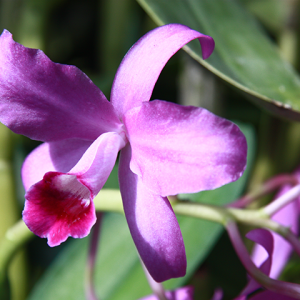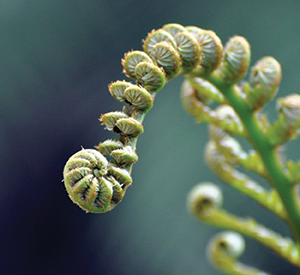The plants displayed here are largely from tropical habitats; they need a warmer and more humid environment than can be provided outdoors. These are a small subset of the Garden’s extensive collections. We change this display regularly in order to show the great diversity in flower and leaf forms.
Orchids
The orchid family (Orchidaceae)—one of the largest of all plant families—has as many as 27,000 species! Orchids occur in a wide range of habitats all over the world, even in the arctic, but not Antarctica. Though known for showy flowers, many are small and inconspicuous.
Many orchids are epiphytes—plants that grow on other plants, but are not parasites. Epiphytic orchids show many adaptations to conserve moisture, such as thick, fleshy leaves and stems (pseudo-bulbs) that store collected water. The white, outer layer covering their roots (velamen) acts like a sponge absorbing water.
Orchid flowers have 3 petals and 3 sepals; the lip—a modified petal—acts as an attractant and a landing pad, often with pollen guides. Some orchids mimic the look and smell of a receptive female bee to attract a male bee that might pollinate the flower while trying to mate.
 Ferns
Ferns
Ferns are an ancient lineage of non-flowering plants that reproduce by spores. There are many families of ferns found all over the world. Ferns occur in a variety of habitats from the tropics to the desert; they can be aquatic, terrestrial or epiphytic.
 Carnivorous Plants
Carnivorous Plants
Carnivorous plants are not from closely related plant families, but they are grouped together because of their fascinating ability to capture and consume animals. Carnivory in plants may have evolved as a means to colonize nutrient-poor environments. They are found all over the world in bogs, fens, and other moist habitats. The carnivorous plants on display show a variety of traps and forms.

